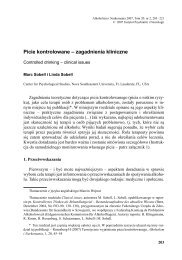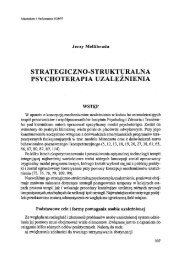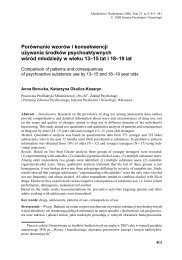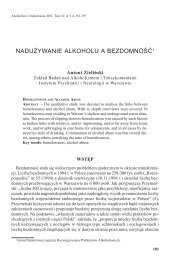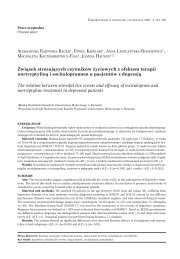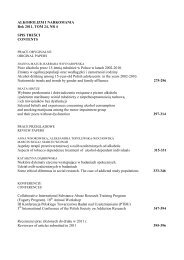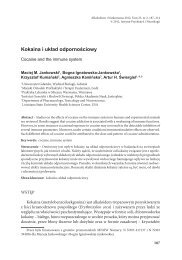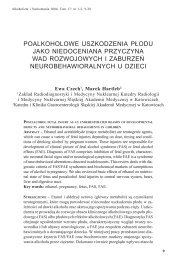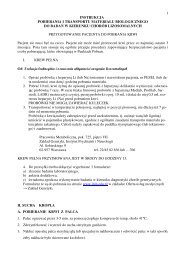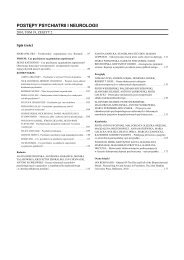WZORY PICIA WÅRÃD MÅODZIEÅ»Y - Instytut Psychiatrii i Neurologii
WZORY PICIA WÅRÃD MÅODZIEÅ»Y - Instytut Psychiatrii i Neurologii
WZORY PICIA WÅRÃD MÅODZIEÅ»Y - Instytut Psychiatrii i Neurologii
Create successful ePaper yourself
Turn your PDF publications into a flip-book with our unique Google optimized e-Paper software.
Janusz Sieroslawski, Antoni Zieliński<br />
Młodzież akceptuje różne wzory picia, odznacza się dużym stopniem tolerancji na<br />
odmienności zachowań alkoholowych. Młodym ludziom trudno zdobyć się na refleksje<br />
na temat alkoholu, picia własnego i przyjaciół. Uświadamianą korzyścią z<br />
picia jest osiągnięcie stanu nazywanego "luzem"- stanu szczególnie cenionego wśród<br />
nastolatków. Młodzież rzadko doświadcza negatywnych następstw picia i nie przywiązuje<br />
do nich większej wagi. Dorośli - rodzice i wychowawcy - mają dwuznaczny<br />
stosunek do picia przez ich podopiecznych. Z jednej strony stwarzają pozory braku<br />
przyzwolenia, z drugiej starają się nie dostrzegać, że młodzież pije. Do interwencji<br />
dochodzi zwykle, gdy picie jest zbyt widoczne i powoduje problemy.<br />
Slowa kluczowe: młodzież, wzory picia, metody jakościowe<br />
Janusz Sierosławski, Antoni Zieliński<br />
Drinking patterns among youth - qualitative approach<br />
SUMMARY<br />
The aim ofthe presented research was to show the role that a1cohol plays in the social<br />
life ofyouth. The key categories for our analysis ofthe problem are drinking pattems and<br />
the consequences of drinking. The subjects ofthe research were drinking pattems among<br />
youth aged between 15 and 17, related to the following situations: a youth party, a meeting<br />
at a pub, a disco, a school trip, a sport event, a band concert.<br />
The research was conducted applying quantitative methods (intensified interviews,<br />
group interview, accompanying observations).<br />
The results of the research showed significant variability of the drinking pattems<br />
depending on the type ofsituation. The rhythm ofdrinking was a bit different in each<br />
pattem, but the common feature of most ofthem was drinking initially of a portion of<br />
alcohol which caused being tipsy. The youth accepts various drinking pattems; they<br />
have wide tolerance for various types of alcohol behaviour. It is hard for young people<br />
to think about a1cohol, their own and their fiiends drinking. They realize the<br />
advantage of drinking which is reaching the state of being "Iaid-back" - the state<br />
really valued among youth. They rarely experience the negative consequences of<br />
drinking and do not consider them. Adults - parents and teachers - have ambiguous<br />
attitude towards drinking by the youth. On one hand they seem not to aJlow them to<br />
do it, on the other hand they try not to see, that the youth drinks. They intervene<br />
usually when drinking is too obvious and causes problems.<br />
Key words: youth, drinking pattems, qualitative methods<br />
284<br />
PIŚMIENNICTWO<br />
l. Dencin N.K., Lincoln Y.S. (1997) Wkraczallie lIa Pole Badań Jakościowych. Wprowadzellie<br />
do Podręcznika. W: Socjologia Wychowania X[[J, Acta Uniwersitas Nicolai Copemici, Toruń,<br />
ss. 4-39.



